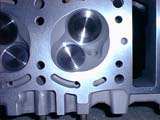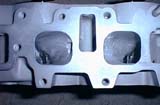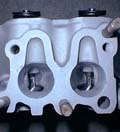Other engine modifications |
||||||||||||||||||||||||||||||||||||||||||||||||||||||||||||||||
|
You can't expect to get maximum performance by bolting on a few trick pieces -- a properly designed turbo setup takes a lot into account, from the volume of the exhaust tubing to the shape of the head's intake ports. While I don't claim to have been a total fanatic when setting up my engine, I have made some significant modifications to a variety of pieces. The major turbo-related pieces I've explained elsewhere; let me try to cover the odds and ends here. |
||||||||||||||||||||||||||||||||||||||||||||||||||||||||||||||||
|
|
||||||||||||||||||||||||||||||||||||||||||||||||||||||||||||||||
Cylinder Head ModsI can't overstate the importance of a properly set up cylinder head -- it's the real key to making all of the other performance mods come together. In my case, I decided to let LC Engineering modify my head -- they've been modifying 22R-series Toyota engines for a lot longer than I have, and if they haven't figured out how to extract every last bit of power from a cylinder head by now they should be ashamed of themselves. I had them port and polish the runners, install 1mm oversize valves, and stiffer valve springs. They also pressure tested the original 22R-TE head and checked it for warpage. Additionally, they did a five angle valve job (three on the valve and two on the seat) and bead-blasted the head. Later, after deciding to change cams, I added LC's dual valve springs, titanium retainers, hardened keepers, and improved rocker arm shafts, which came to another $350 or so. Not cheap, but very well made pieces. Total cost of the cylinder head mods (including a cam, but not including the above valve train items): $1080. Not cheap. but money that I feel was well spent. If I were to do it over again, I might go with even bigger valves, but this might require that bigger valve reliefs be machined into the tops of the pistons, something I wasn't into at the time (not wanting to disassemble the bottom end...)
Cam
I've read a variety of opinions about the proper specs for a turbo cam -- from Corky Bell's advice to "use the stock one: it'll work fine and you're unlikely to improve on it" to others' suggestions for cams with longer duration and greater lift. The first aftermarket cam I installed was a custom turbo grind from LC Engineering. They didn't provide me with the specs (cam card was inaccurate), but I do know the cam had 114* lobe centers. This cam produced a lot of torque, but the power band was very narrow (3k - 4.5k). I feel that the wide lobe separation was probably not a good match for my particular needs/driving style. ($160 from LC Engineering.) The second aftermarket cam I installed was a Competition Cams 268S grind. I found that this cam produced very smooth power, and revved happily to 6k. Unfortunately, this cam had a lot of overlap (periods when both the intake and exhaust valves were open), and on a turbo motor, the pressurized intake charge gets pushed through the cylinder and right out the exhaust. Not very efficient. Others have claimed to love this cam, but I didn't feel that it made all that much power, and I noticed a definite loss of torque. At least the cam is cheap ($109 from Summit Racing). I left this cam in for about two weeks, and then pulled it.
The third (and hopefully final) aftermarket cam I installed was the DOA Racing Engines CT/270 cam. As Goldilocks said, this one was just right. Lots of torque, nice fat powerband, revs pretty happily, very little overlap. I like it, and I think I can honestly say I now have some experience with cams in this engine. If you like torque and a fat powerband, I think you might like this cam, too. ($155 from DOA Racing Engines.)
Adjustable Cam Gear
Adjustable cam gears allow you to fine tune your cam timing, advancing or retarding the cam in relation to the crank. This is a necessity if you want to degree in your camshaft (highly recommended), and very useful for fine tuning your cam for performances purposes. A good discussion of cam timing, including a description of how to degree in a cam on a 22R-series engine, can be found here. The LC Engineering adjustable cam gear is a cool little piece that can add about 5 hp when properly tuned. I have mine set to about 2 degrees advanced, which seems to give me a subtle but noticeable power increase over stock. At $95, the gear is a little pricey, but worth it if you want to be able to really fine tune your engine.
Rocker Arm Mod
|
||||||||||||||||||||||||||||||||||||||||||||||||||||||||||||||||
|
|
|
As I said above, I haven't tried this myself...but you only have to chew up one camshaft (and have it chew up some more expensive parts) to make this look like the right thing to do.
Throttle Body
I had LC Engineering bore out my throttle body by 3.5 mm. They did a beautiful job, modifying not just the butterfly area but also taper boring the "throat" of the unit. There are others who will do it cheaper (LC charges $295 + exchange) but I'm not convinced that anyone will do it better.
This part (installed before the turbo upgrade) made a real difference in top end performance. I didn't notice any degradation in low end performance, and, when coupled with the bigger exhaust, this was a potent upgrade. I highly recommend this for 22R-TE owners.
Dual Width Timing Chain Conversion
I decided to change my timing chain at about 115k miles, before it broke. After doing some reading, I decided to use LC's dual width timing chain conversion kit.
There's some debate as to whether this conversion is actually worthwhile; certainly few people who spend the $400+ for this kit are going to admit that maybe they didn't need it... Still, with the increased boost I was planning to run, I felt that this was a prudent move.
Once I got the single width chain off and looked at it, I felt a lot better about spending the money. The decision to go with a single width chain was made by a bean counter, not an engineer. Further, the original guides were bakelite (or a similar synthetic material) and one was already cracked. The new chain appears to be quite well made and should last for many , many thousands of miles.
This is they type of upgrade that doesn't add performance, but it will allow you to safely add other parts that WILL add more performance.
1/13/99: D.O.A. Racing Engines has a set of single width, metal-backed timing chain guides that are a direct replacement for the stock plastic/composite/bakelite pieces, only much stronger. Since the plastic guides are the pieces that fail most often, replacing these with metal-backed parts makes a lot of sense, and dramatically improves the life of the timing chain assembly. It's also a lot cheaper than doing the above conversion. If money is tight,consider this as a viable option.
Head Studs (as a replacement for head bolts)
American Racing Products (ARP) makes a variety of special purpose fasteners for racing applications, including a head stud kit for Toyota 22R-series engines. These kits are available from LC Engineering, as well as Summit Racing and a number of other racing parts suppliers. (Hint: LCE is NOT going to be the cheapest source for this part.)
A few words about studs: A number of engineering tests have demonstrated that studs are significantly stronger than bolts, and the ARP studs are beauties: they are made from extremely high tensile strength steel. Typical head bolts have a lifespan of about two "torquings" -- some would say that even this subjects them to too much stress. The ARP studs are good for more than that, although the very prudent would still be reluctant to reuse any part like a stud or especially a head bolt more than twice.
When a cylinder head bolt is torqued, the atoms of the bolt are stressed axially and torsionally, while the atoms of the cylinder head are stressed radially. All bolts have a certain amount of elasticity, and properly torquing your bolts relieves the bolt of this elasticity. Because there is only one threaded surface on a head bolt, a tremendous amount of stress is concentrated at the bolt's threads; however, as the bolt is tightened, a lot of torsional force is applied to the area near the bolt's head, and along the length between the bolt’s head and the beginning of the threads. The result is a bolt that has axial stress and torsional stress. When combined with the heating and cooling action of the engine, the bolt weakens considerably over time. A hot performance engine only increases the rate of this fatigue.
A stud is a different beast. The threads at its base secure it to the block, while the nut and threads at the top allow it to be torqued without the addition of torsional stress along its length (or not much, at any rate). The result is a fastener that can be subjected to greater stress while still delivering greater life, because the stress is generally distributed axially along its length, rather than axially AND torsionally.
I am *very* impressed with these units, and recommend them highly: they are beautifully made, and they have an incredible feel to them as you work with them. Their greater strength allows for greater torque when you bolt up your cylinder head (80 lbs. vs. the stock head bolts’ 58 lbs.), which should extend the life of your head and head gasket, especially if you are building a 200+ hp motor. If you are just rebuilding a stock motor, it probably isn't worth the money, as the stock bolts are perfectly adequate for stock hp...as long as the bolts are fresh!! People run into problems when they try to reuse head bolts too many times, especially with a hot motor. For my needs, though, I think these are a necessary and welcome part.
Bigger Injectors
More air flow requires more fuel, and a serious upgrade like a bigger turbo is going to require more fuel, potentially, than the stock 295 cc/minute injectors are capable of providing.
I elected to go with RC Engineering's 320 cc/minute Lucas-style injectors. Now, if I were also changing the stock air flow sensor to a better (i.e., less restrictive) setup, like a MAP sensor or a Karman Vortex unit, I could go with even bigger injectors, but I wasn't, so I didn't (there are limits to my truck budget, and this was one of them...) Still, the new injectors flowed significantly more fuel than the stock injectors, and required some serious tweaking of the MAF. I'll flesh this out into a separate topic in the future, but for the moment, let me just say that this was a good and necessary addition.
Total cost for 4 new injectors: $368
Rising Rate Fuel Pressure Regulator
Well, I have one (from Bell Engineering Group), but I'm no longer using it. I am now convinced that this is not the proper way to address fuel management issues. Rising rate fuel pressure regulators (RRFPR) add more fuel to the engine by increasing fuel pressure as boost rises. In other words, they raise fuel pressure proportionally in response to increases in manifold pressure. Since a typical baseline for EFI fuel pressure is 38 psi or so, and these units can increase fuel pressure by 1 to 4 psi for each 1 psi of boost, they are capable of generating some absurdly high fuel pressures -- on the order of 130+ psi for highly boosted engines. It doesn't take a genius to realize that at some point, this amount of pressure will prevent the injectors from opening.
For low boost systems (<8psi), these units may make sense, especially if a normally aspirated EFI system is being converted to a turbo EFI system. For turbo systems that use more than 8 psi of boost, a RRFPR not a sound approach.
Rather than using a RRFPR as a bandaid to an underdesigned fuel management system, I am convinced that a proper match between injectors, ECU and engine demands is the only way to go. Anything short of this is an invitation to trouble.




